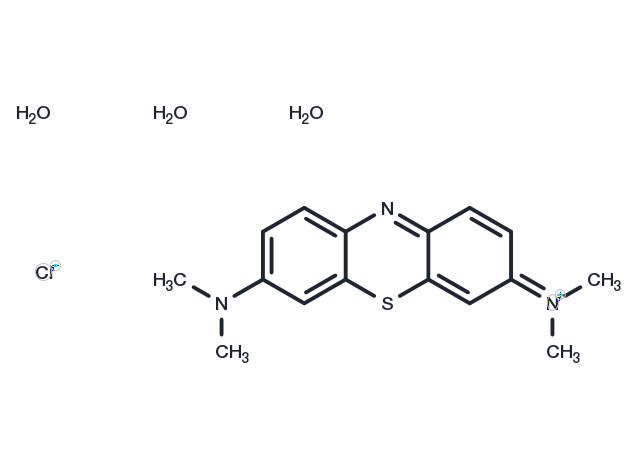store at low temperature,keep away from direct sunlight
Powder: -20°C for 3 years | In solvent: -80°C for 1 year

Methylene Blue trihydrate (Basic blue 9) is a compound consisting of dark green crystals or crystalline powder, having a bronze-like luster. Solutions in water or alcohol have a deep blue color. Methylene Blue trihydrate is used as a bacteriologic stain and as an indicator. It inhibits soluble guanylyl cyclase and has been used to treat cyanide poisoning and to lower levels of methemoglobin. It also inhibits tau filament formation (IC50: 1.9μM).

| Pack Size | Availability | Price/USD | Quantity |
|---|---|---|---|
| 10 g | In stock | $ 42.00 |






| Description | Methylene Blue trihydrate (Basic blue 9) is a compound consisting of dark green crystals or crystalline powder, having a bronze-like luster. Solutions in water or alcohol have a deep blue color. Methylene Blue trihydrate is used as a bacteriologic stain and as an indicator. It inhibits soluble guanylyl cyclase and has been used to treat cyanide poisoning and to lower levels of methemoglobin. It also inhibits tau filament formation (IC50: 1.9μM). |
| Targets&IC50 | Tau filament:1.9μM |
| Synonyms | Methylthionine chloride, Basic blue 9, Methylene Blue |
| Molecular Weight | 373.9 |
| Formula | C16H24ClN3O3S |
| CAS No. | 7220-79-3 |
store at low temperature,keep away from direct sunlight
Powder: -20°C for 3 years | In solvent: -80°C for 1 year
DMSO: 3.67 mg/ml
You can also refer to dose conversion for different animals. More
bottom
Please see Inhibitor Handling Instructions for more frequently ask questions. Topics include: how to prepare stock solutions, how to store products, and cautions on cell-based assays & animal experiments, etc.
Methylene Blue trihydrate 7220-79-3 Cytoskeletal Signaling GPCR/G Protein Immunology/Inflammation Microbiology/Virology Neuroscience Guanylate cyclase Microtubule Associated NO Synthase Parasite Monoamine Oxidase cGMP dye sGC Inhibitor inhibit antimalarial Methylthionine chloride MAO-A Nitric oxide synthases C.I. Basic Blue 9 Methylene Blue Trihydrate Basic blue 9 methemoglobinemias anxiolytic Guanylate Cyclase antidepressant Methylthionine Chloride MAO vasopressor antinociception NOS Methylene Blue inhibitor
